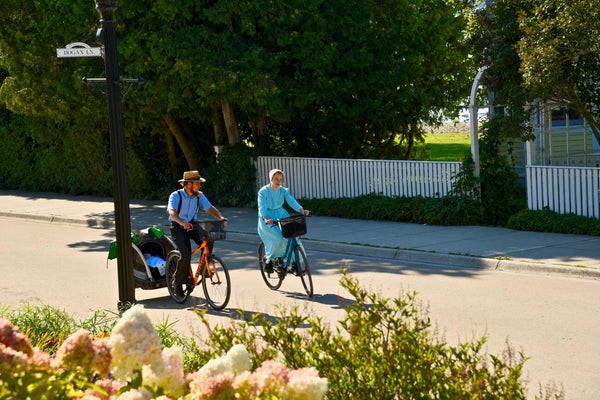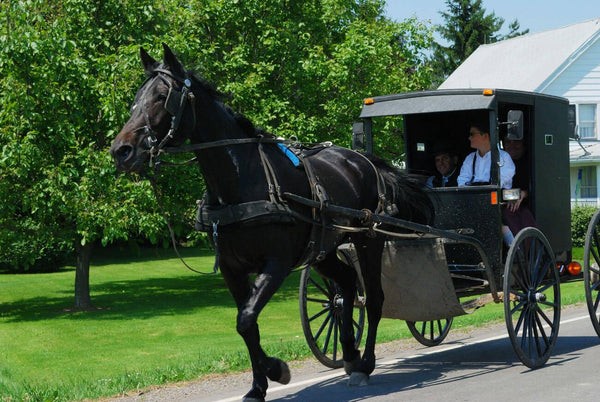Do Amish People Drive Cars? Exploring the transportation methods of the Amish community offers a fascinating glimpse into their unique cultural practices and beliefs. At CARS.EDU.VN, we delve into this topic, shedding light on how the Amish navigate the modern world while upholding their traditional values, providing you with detailed insights and answers. Learn more about Amish travel customs, their views on motorized transport, and the intricate balance they maintain between tradition and practicality, ensuring your understanding of Amish life.
1. How Do the Amish Primarily Travel?
The Amish predominantly travel using horse-drawn buggies, a practice deeply rooted in their cultural identity and religious beliefs. These buggies are not merely a means of transportation; they symbolize the Amish commitment to simplicity, community, and separation from the modern world. The use of horse and buggy reinforces their agrarian lifestyle and minimizes exposure to worldly influences.
1.1. Design and Safety Features of Amish Buggies
Amish buggies are designed with safety and practicality in mind, incorporating features that ensure the well-being of their occupants.
-
Sturdy Construction: Buggies feature a solid steel frame, providing a robust structure capable of withstanding various road conditions.
-
Spring Suspension: The spring suspension system ensures a comfortable ride by absorbing shocks and vibrations, particularly important on uneven rural roads.
-
Effective Brakes: Buggies are equipped with reliable braking systems, often including hand brakes, to allow for safe and controlled stopping.
-
Lighting: To enhance visibility, buggies often include headlights and taillights, especially crucial during early morning or late evening travel. Reflectors are also commonly used.
-
Weather Protection: Enclosed sides and roofs protect passengers from the elements, offering shelter from rain, snow, and harsh sunlight.
These features reflect the Amish dedication to practicality and safety while maintaining their traditional way of life.
1.2. Care and Maintenance of Horses
The horses that power Amish buggies receive exceptional care, reflecting the Amish respect for animals and their dependence on them for transportation and agricultural work.
-
Quality Feed: Horses are fed a nutritious diet consisting of high-quality hay, grains, and supplements to ensure they remain healthy and strong.
-
Regular Exercise: Daily exercise is crucial for maintaining the horse’s physical condition. This includes pulling the buggy, working in the fields, and general movement around the farm.
-
Veterinary Care: Amish horse owners regularly consult with veterinarians to ensure their horses receive necessary vaccinations, dental care, and treatment for any health issues.
-
Proper Grooming: Horses are groomed regularly to keep their coats clean and prevent skin problems. This also allows owners to check for any signs of injury or illness.
-
Comfortable Shelter: Horses are provided with comfortable and clean stables, protecting them from harsh weather conditions and ensuring they have a safe place to rest.
This diligent care ensures that the horses remain healthy, reliable, and well-suited for their role in the Amish community.
2. Alternative Modes of Transportation in Amish Communities
While horse and buggy remain the primary mode of transport, the Amish employ other methods to navigate their daily lives, each with its own set of guidelines and acceptance levels within different communities.
2.1. Bicycles and Scooters
Bicycles and scooters are permitted in some Amish communities, particularly in the Midwest, offering a practical alternative for shorter distances.
-
Acceptance Variation: The use of bicycles varies among different Amish affiliations. Some communities readily accept them, while others have stricter regulations or prohibit them entirely.
-
Common Areas: In areas like Holmes County, Ohio, and the Shipshewana and Nappanee regions of Indiana, bicycles are frequently used by the Amish for local travel.
-
Amish Scooters: Amish scooters are a popular alternative, featuring larger wheels, higher ground clearance, and robust frames for durability on unpaved roads. They often include practical features such as baskets, bells, and reliable braking systems.
Bicycles and scooters provide a balance between practicality and adherence to traditional values, allowing for efficient local transportation.
2.2. Public Transportation: Trains and Buses
For longer distances, the Amish may utilize public transportation such as trains and buses, particularly for attending significant events or traveling to specific destinations.
-
Train Travel: Trains are sometimes used for traveling longer distances to attend weddings, funerals, or other important family gatherings.
-
Bus Services: Similar to trains, buses offer another option for reaching destinations that are too far for horse and buggy travel.
-
Limited Use: The use of public transportation is typically reserved for essential travel needs, reflecting the Amish preference for simpler, less worldly modes of transport.
By using public transportation sparingly, the Amish can maintain their separation from mainstream society while still meeting their travel requirements.
2.3. Hiring Non-Amish Drivers
A common practice among the Amish is to hire non-Amish drivers, often referred to as “Amish haulers” or “Amish taxi drivers,” to transport them in cars.
-
Practical Solution: This arrangement allows the Amish to travel long distances without compromising their religious beliefs against owning or operating motor vehicles.
-
Local Services: Many non-Amish individuals provide transportation services specifically for the Amish, offering a reliable means of travel.
-
Acceptable Arrangement: Since the Amish are not in control of the vehicle, this arrangement is generally considered acceptable within their cultural norms.
-
Fees: Amish haulers typically charge a fee for their services, making it a viable business for those in the surrounding communities.
This practice provides a practical solution for the Amish to participate in events and activities that require long-distance travel while adhering to their religious principles.
3. Amish Beliefs About Technology and Modern Conveniences
The Amish approach to technology is rooted in their desire to maintain a simple, community-focused way of life, free from the perceived distractions and temptations of the modern world.
3.1. Reasons for Limited Technology Use
The Amish limit their use of technology for several key reasons:
-
Preservation of Community: They believe that excessive technology can lead to individualism and weaken community bonds.
-
Avoidance of Worldly Influences: The Amish seek to remain separate from the “worldly” influences that they believe can corrupt their values and faith.
-
Focus on Simplicity: Technology is seen as a complication that detracts from a simple, agrarian lifestyle centered on family, community, and faith.
-
Prevention of Vanity and Materialism: The Amish believe that technology can foster vanity and a focus on material possessions, which they reject in favor of spiritual values.
3.2. Examples of Technology Used (or Not Used) in Amish Life
While the Amish generally avoid modern technology, there are nuances and exceptions depending on the community and specific technology in question.
| Technology | Use | Rationale |
|---|---|---|
| Electricity | Generally not used in homes; may be used in businesses under specific circumstances. | Dependence on electricity can lead to reliance on outside systems and undermine self-sufficiency. |
| Telephones | Often limited to shared community phones; cell phones may be permitted for business use in some communities. | Excessive personal phone use can disrupt family and community life. |
| Computers & Internet | Generally avoided; may be permitted for specific business purposes with strict guidelines to prevent misuse. | Internet access is seen as a gateway to worldly influences and potential moral corruption. |
| Motorized Vehicles | Generally prohibited for personal ownership; hiring non-Amish drivers is an acceptable alternative for essential travel. | Owning and operating cars can lead to individualism, competition, and dependence on the outside world. |
| Modern Machinery | May be used in farming and business with modifications to limit reliance on external power sources (e.g., using pneumatic power). | The goal is to balance efficiency with maintaining self-sufficiency and avoiding dependence on external systems. |
| Alternative Energy | Use of solar power for specific applications is becoming more common, balancing technology use with environmental stewardship. | Solar power can provide a degree of self-sufficiency without the dependence on public utilities that contradicts Amish values. |




3.3. Differences Between Old Order and New Order Amish
The Amish community is not monolithic; there are variations in how different groups approach technology. The main distinction lies between the Old Order and New Order Amish.
-
Old Order Amish: This group adheres to the most traditional practices, strictly limiting technology to preserve their way of life. They typically avoid electricity, motorized vehicles, and modern machinery.
-
New Order Amish: The New Order Amish are more open to modern conveniences, allowing some technologies that the Old Order Amish reject. They might use motorized vehicles in moderation and permit certain electrical appliances, while still emphasizing the importance of self-reliance and community.
This difference reflects a spectrum of beliefs within the Amish community, each seeking to balance tradition with the practicalities of modern life.
4. Do Amish People Drive Cars? The Definitive Answer
The definitive answer to whether Amish people drive cars is generally no. However, the nuances of this answer reveal much about Amish culture, values, and adaptability.
4.1. Prohibition of Owning and Driving Cars
The Amish typically do not own or drive cars due to their religious beliefs and cultural values. This prohibition stems from a desire to remain separate from the world, maintain community cohesion, and avoid the potential for pride and materialism that can come with car ownership.
4.2. Scriptural Basis and the Ordnung
The Amish base their rejection of car ownership and driving on both scriptural interpretations and the Ordnung, the unwritten code of conduct that guides Amish life.
-
Scriptural Basis: Verses such as Romans 12:2, which encourages believers not to conform to the patterns of the world, are often cited as a basis for avoiding modern technology.
-
The Ordnung: This code sees driving as a potentially alienating and frivolous activity that can lead to pride and arrogance, undermining the values of humility and community.
4.3. Loopholes and Exceptions: Hiring Drivers
Despite the general prohibition, there are acceptable loopholes that allow the Amish to travel in cars when necessary.
-
Hiring Non-Amish Drivers: The most common exception is hiring non-Amish drivers to provide transportation. This allows the Amish to travel long distances for essential purposes without directly violating their beliefs against owning or operating cars.
-
Emergency Situations: In emergency situations, such as medical emergencies or urgent family matters, the Amish may use cars or other motorized vehicles to reach their destination quickly.
These exceptions highlight the Amish community’s ability to adapt to modern life while maintaining their core values and beliefs.
5. Respecting Amish Choices and Values
The Amish approach to transportation and technology reflects deep-seated values of humility, simplicity, and community. Understanding and respecting these values is crucial to appreciating their way of life.
5.1. The Importance of Humility and Simplicity
The Amish choose simpler modes of transportation and limit their use of technology to cultivate humility and avoid the trappings of modern life. This focus on simplicity allows them to concentrate on their faith, family, and community.
5.2. Maintaining Separation from the World
By avoiding cars and other modern conveniences, the Amish seek to maintain a separation from the world, minimizing external influences that they believe can corrupt their values and faith.
5.3. The Amish as an Integral Part of Our Culture
Despite their distinct way of life, the Amish remain an integral part of our culture and history. Their traditional values and strong sense of community offer valuable lessons for all.
6. FAQs About Amish Transportation
1. Why don’t Amish people drive cars?
The Amish don’t drive cars to maintain separation from the world, foster community, and avoid pride and materialism.
2. How do the Amish travel long distances?
They hire non-Amish drivers or use public transportation like trains and buses.
3. Are there any exceptions to the Amish not driving cars?
Yes, in emergencies or when hiring a driver, the Amish may travel in cars.
4. Do all Amish communities have the same rules about transportation?
No, rules vary between Old Order and New Order Amish, with the latter being more open to modern conveniences.
5. What is the Amish Ordnung?
It is an unwritten code of conduct that guides Amish life and influences their decisions on technology and transportation.
6. How do the Amish care for their horses?
They provide quality feed, regular exercise, veterinary care, and comfortable shelter for their horses.
7. Do Amish people use bicycles?
Some Amish communities allow bicycles and scooters for local transportation.
8. How do Amish beliefs about technology affect their daily lives?
They prioritize simplicity, community, and faith over modern conveniences, limiting technology use to preserve these values.
9. What are “Amish haulers”?
They are non-Amish individuals who provide transportation services to the Amish for a fee.
10. How can I learn more about Amish culture and traditions?
Visit CARS.EDU.VN for detailed insights and resources on Amish life and practices.
7. Staying Informed About Automotive Trends with CARS.EDU.VN
While exploring the unique transportation choices of the Amish, CARS.EDU.VN remains your trusted source for all things automotive. We offer comprehensive information and resources for car owners, enthusiasts, and anyone seeking to stay informed about the latest trends in the automotive industry.
7.1. Comprehensive Information on Car Care and Maintenance
At CARS.EDU.VN, we understand the challenges car owners face in maintaining their vehicles. We provide detailed guides and expert advice to help you keep your car running smoothly and efficiently.
-
Routine Maintenance: Learn about essential maintenance tasks such as oil changes, tire rotations, and brake inspections.
-
Troubleshooting: Access resources to help diagnose and fix common car problems, saving you time and money.
-
Seasonal Care: Discover tips for preparing your car for different weather conditions, ensuring optimal performance and safety year-round.
7.2. Expert Reviews and Comparisons of Vehicles
Choosing the right vehicle can be overwhelming. CARS.EDU.VN offers expert reviews and comparisons to help you make an informed decision.
-
Detailed Reviews: Read comprehensive reviews of the latest car models, covering performance, safety, and features.
-
Comparative Analysis: See how different vehicles stack up against each other in terms of price, fuel efficiency, and reliability.
-
Personalized Recommendations: Get recommendations tailored to your specific needs and preferences, whether you’re looking for a family-friendly SUV or a fuel-efficient commuter car.
7.3. Latest News and Technologies in the Automotive Industry
Stay up-to-date with the latest developments in the automotive industry with CARS.EDU.VN.
-
New Model Releases: Get the scoop on upcoming car models, including design changes, technological innovations, and performance upgrades.
-
Technological Advancements: Learn about the latest advancements in electric vehicles, autonomous driving, and connectivity features.
-
Industry Trends: Stay informed about emerging trends in the automotive market, such as the rise of electric mobility and the increasing focus on sustainability.
By providing this comprehensive coverage, CARS.EDU.VN ensures you have the knowledge and resources to navigate the ever-evolving world of automobiles.
8. How CARS.EDU.VN Addresses Customer Needs
Understanding the challenges and needs of our audience is at the heart of what we do at CARS.EDU.VN. We strive to provide solutions that address your concerns and enhance your car ownership experience.
8.1. Addressing Customer Challenges
We recognize the common difficulties car owners face:
-
Finding Reliable Repair Services: Identifying trustworthy and competent repair shops can be stressful. CARS.EDU.VN provides resources to help you find reputable service providers in your area.
-
Lack of Maintenance Knowledge: Many car owners lack the knowledge to perform basic maintenance tasks. Our easy-to-understand guides empower you to take care of your car and prevent costly repairs.
-
Vehicle Selection: Choosing the right vehicle can be daunting. Our expert reviews and comparisons simplify the process, helping you find a car that fits your needs and budget.
-
DIY Repairs: Tackling minor car repairs can be intimidating. We offer step-by-step instructions and helpful tips to guide you through simple fixes.
-
Staying Updated: Keeping up with the latest automotive technology can be challenging. We provide timely news and insights to keep you informed about industry trends.
8.2. Services Offered by CARS.EDU.VN
CARS.EDU.VN offers a range of services to meet your automotive needs:
-
Detailed Service Information: Access comprehensive information about car care and repair services, helping you understand what your car needs and how to address any issues.
-
Easy-to-Understand Maintenance Guides: Follow our simple guides to perform routine maintenance tasks, ensuring your car stays in top condition.
-
In-Depth Vehicle Reviews: Make informed decisions with our expert reviews and comparisons of various car models and brands.
-
DIY Repair Guides: Save money and gain confidence with our step-by-step guides for handling minor car repairs.
-
Automotive News and Technology Updates: Stay ahead of the curve with our coverage of the latest news and technological advancements in the automotive industry.
8.3. Call to Action
Ready to explore the world of automotive knowledge and find the solutions you need? Visit CARS.EDU.VN today to discover detailed service information, expert reviews, DIY guides, and the latest industry news. Let us help you enhance your car ownership experience and keep you informed every step of the way. For more information, visit our website at CARS.EDU.VN or contact us at 456 Auto Drive, Anytown, CA 90210, United States. You can also reach us via WhatsApp at +1 555-123-4567.
At cars.edu.vn, we are committed to providing you with the information and resources you need to make informed decisions about your vehicle. Visit us today and experience the difference!